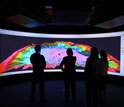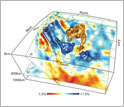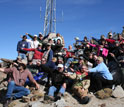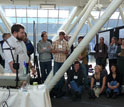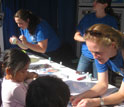News Release 11-092
NSF Selects Arizona State University to Host Next EarthScope National Office
Primary coordination point for EarthScope science, education and outreach activities
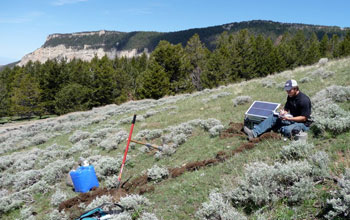
University of Colorado student Jeremiah Silver downloads EarthScope data from a seismic station.
May 9, 2011
This material is available primarily for archival purposes. Telephone numbers or other contact information may be out of date; please see current contact information at media contacts.
The National Science Foundation (NSF) has awarded $2.4 million to Arizona State University (ASU) to serve as the next host for the EarthScope National Office.
The national office fosters and supports integrated science, education and outreach, and related activities for EarthScope scientists.
EarthScope is an NSF-funded Earth science program that explores the four-dimensional structure of the North American continent.
The nucleus of the program is the EarthScope Facility, a multi-purpose array of instruments and observatories consisting of the Plate Boundary Observatory, the San Andreas Fault Observatory at Depth, and the USArray.
"These observatories provide an unprecedented amount of geophysical and geological data to address the processes that formed and continue to shape North America," says Greg Anderson, EarthScope program director at NSF.
EarthScope provides a framework for studies across the Earth sciences, including research on active deformation of the North American continent; evolution of the North American continent through geologic time; deep Earth structure and dynamics; earthquakes, faults and the rheology--flow of matter--in Earth's outermost shell--the crust and upper mantle; magma, water and volatiles--meaning chemicals with low boiling points in the crust and mantle; Earth's topography and tectonics; research on the hydrosphere, cryosphere and atmosphere; and geoscience education topics.
The first EarthScope national office was established in 2007 at Oregon State University under the direction of geoscientist Anne Tréhu, and has served since then as a nexus for a wide range of scientific and educational activities related to EarthScope.
"The national office is a critical part of EarthScope," says Anderson. "It's the primary coordination point for the EarthScope scientific community--a place where the community learns what's happening with EarthScope, and EarthScope scientists can come for help with organizing and planning workshops and other activities."
Ramon Arrowsmith, a geoscientist at ASU, will serve as director of the next EarthScope national office. Deputy director will be Steve Semken, a geoscience education researcher; Semken will lead education and outreach activities for EarthScope.
"EarthScope gives us a unique view of the Earth's structure and processes," says Arrowsmith. "The scientific community that has gathered around the resulting data and research questions is answering some of the most outstanding questions in the Earth sciences."
Adds Semken, "EarthScope research is being conducted at a fine scale across the continent, uncovering Earth features, processes, and history beneath every place, including those regions where surface geology is more subtle.
"These new data are superb resources for place-based Earth science teaching, and the EarthScope national office will facilitate and encourage their use by K-12 and college teachers."
ASU geoscientists Ed Garnero and Matt Fouch will be co-principal investigators and provide scientific guidance, and Wendy Taylor, assistant director of ASU's R.S. Dietz Museum of Geology, will be the education and outreach program coordinator.
Several other ASU researchers with geoscience backgrounds also will be involved, as will undergraduate, graduate and postgraduate students.
-NSF-
-
Researchers at the EarthScope-supported Visualization Center, Scripps Institution of Oceanography.
Credit and Larger Version -
EarthScope image of the 3-D seismic velocity structure in the mantle beneath western North America.
Credit and Larger Version -
EarthScope National Office staff members teach park rangers and museum educators about geoscience.
Credit and Larger Version -
Penn State student Lucas Zoet presents EarthScope results at a workshop through the national office.
Credit and Larger Version -
The national office reaches out to the public; shown is the USA Science and Engineering Festival.
Credit and Larger Version
Media Contacts
Cheryl Dybas, NSF, (703) 292-7734, email: cdybas@nsf.gov
Nicole Cassis, Arizona State University, (602) 710-7169, email: nstaab@asu.edu
Related Websites
EarthScope Program: http://www.earthscope.org
EarthScope San Andreas Fault Observatory at Depth (SAFOD): http://www.earthscope.org/observatories/safod
EarthScope Plate Boundary Observatory: http://www.earthscope.org/pbo
EarthScope U.S. Array: http://www.earthscope.org/observatories/usarray
The U.S. National Science Foundation propels the nation forward by advancing fundamental research in all fields of science and engineering. NSF supports research and people by providing facilities, instruments and funding to support their ingenuity and sustain the U.S. as a global leader in research and innovation. With a fiscal year 2023 budget of $9.5 billion, NSF funds reach all 50 states through grants to nearly 2,000 colleges, universities and institutions. Each year, NSF receives more than 40,000 competitive proposals and makes about 11,000 new awards. Those awards include support for cooperative research with industry, Arctic and Antarctic research and operations, and U.S. participation in international scientific efforts.
Connect with us online
NSF website: nsf.gov
NSF News: nsf.gov/news
For News Media: nsf.gov/news/newsroom
Statistics: nsf.gov/statistics/
Awards database: nsf.gov/awardsearch/
Follow us on social
Twitter: twitter.com/NSF
Facebook: facebook.com/US.NSF
Instagram: instagram.com/nsfgov



